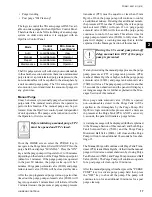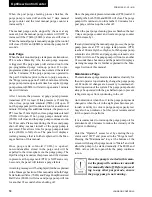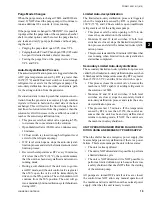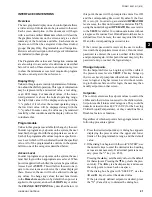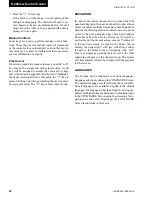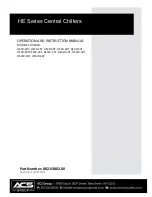
FORM 155.21-O1 (615)
7
JOHNSON CONTROLS
1
Power Panel
The power panel serves as single-point wiring location
for the unit’s incoming power wiring. It houses all the
unit pump contactors and overloads, as well as fuses and
terminal lugs for ease of serviceability. A transformer
is included to reduce the incoming unit voltage to the
micropanel.
Isolation Valve
One isolation valve is located at each Buffalo Pump inlet
and outlet. It is a positive sealing, butterfly type valve
mounted between standard ANSI flanges. Each valve
incorporates an EPDM liner on the valve face to act as
a sealing surface. When closed, the valves will isolate
the unit vacuum from the pump area to offer ease of
serviceability when servicing the pumps.
Hot Water Valve
The capacity control valve which regulates the amount
of hot water to the generator (Hot Water units only).
Steam Valve
The capacity control valve which regulates the amount
of steam to the unit (Steam units only).
Oil Trap
The oil trap is located between the purge pump suction
connection and the unit. It is designed so it will hold one
complete oil charge of the vacuum pump. In the event
air was to get into the unit through the vacuum pump,
the low pressure in the absorber would induce the oil
into the system. Therefore, the oil trap is used as a safety
measure to protect the absorption unit from the oil.
Orifice
A restriction in a liquid line for the purpose of reducing
the internal diameter of the line. Usually created by a
blank piece of metal with a small hole drilled into it,
to create a pressure differential when a liquid passes
through it.
Pass Baffle
A division plate or plates (baffles) inserted into a water
box to create chambers which force the water to pass
through different portions of the tube bundle, called
passes. Although the pressure drop increases with in-
creasing passes, the trade-off for heat transfer optimiza-
tion and nozzle locations are justified.
Rupture Disk
Although IsoFlow™ absorption units operate at less than
atmospheric pressure (a vacuum), if certain safeties fail
and/or incorrect valves are closed, the unit could experi-
ence higher pressures in certain chambers. Therefore, a
pressure relief apparatus, a rupture disk, is added.
Automatic De-crystallization Pipe (ADC)
The automatic de-crystallization pipe is a U-shaped line
coming off the generator solution outlet box and termi-
nating in the absorber shell. During normal unit opera-
tion, this line has no flow in it. If crystallization were to
occur, it would normally be in the strong solution side of
the heat exchanger. This blockage would back up solu-
tion into the generator solution and into the automatic
de-crystallization pipe. Once the hot solution goes into
the ADC pipe, it bypasses the heat exchanger and goes
directly into the absorber shell, thus heating the solution
in the absorber shell. The heated solution in the absorber
then heats up the crystallized heat exchanger from the
opposite side of the tubes and causes the crystallized
lithium bromide to dissolve back into solution.
ADC Flush Line
This line runs between the solution pump discharge and
the ADC line. When the solution pump runs, weak solu-
tion is constantly supplied to the ADC line. This keeps
the ADC line from crystallizing, due to it being exposed
to the low pressures generated within the absorber while
the unit is running.
Alcohol (2-Ethylhexanol)
A liquid added to an absorption chiller (about 1% by
mass) to enhance the heat and mass transfer in the Ab-
sorber. It is an octyl alcohol whose chemical name is
2-Ethyl-1-Hexanol (C8H18O) with a molecular weight
of 130.2, a boiling point of 364.3°F (184.6°C), and a
flash point of 177.8°F (81°C) at 760 mmHg. Having a
colorless, clear appearance, it has a somewhat pungent
odor. By adding 2- Ethylhexanol to the absorption cycle,
overall unit performance increases by 5-15%. In addi-
tion, cycle temperatures, pressures, and concentrations
tend to decrease with the addition of 2-Ethylhexanol.
Concentration
The percent by weight of lithium bromide present in
solution. New solution is sent with a concentration of
53%.

















